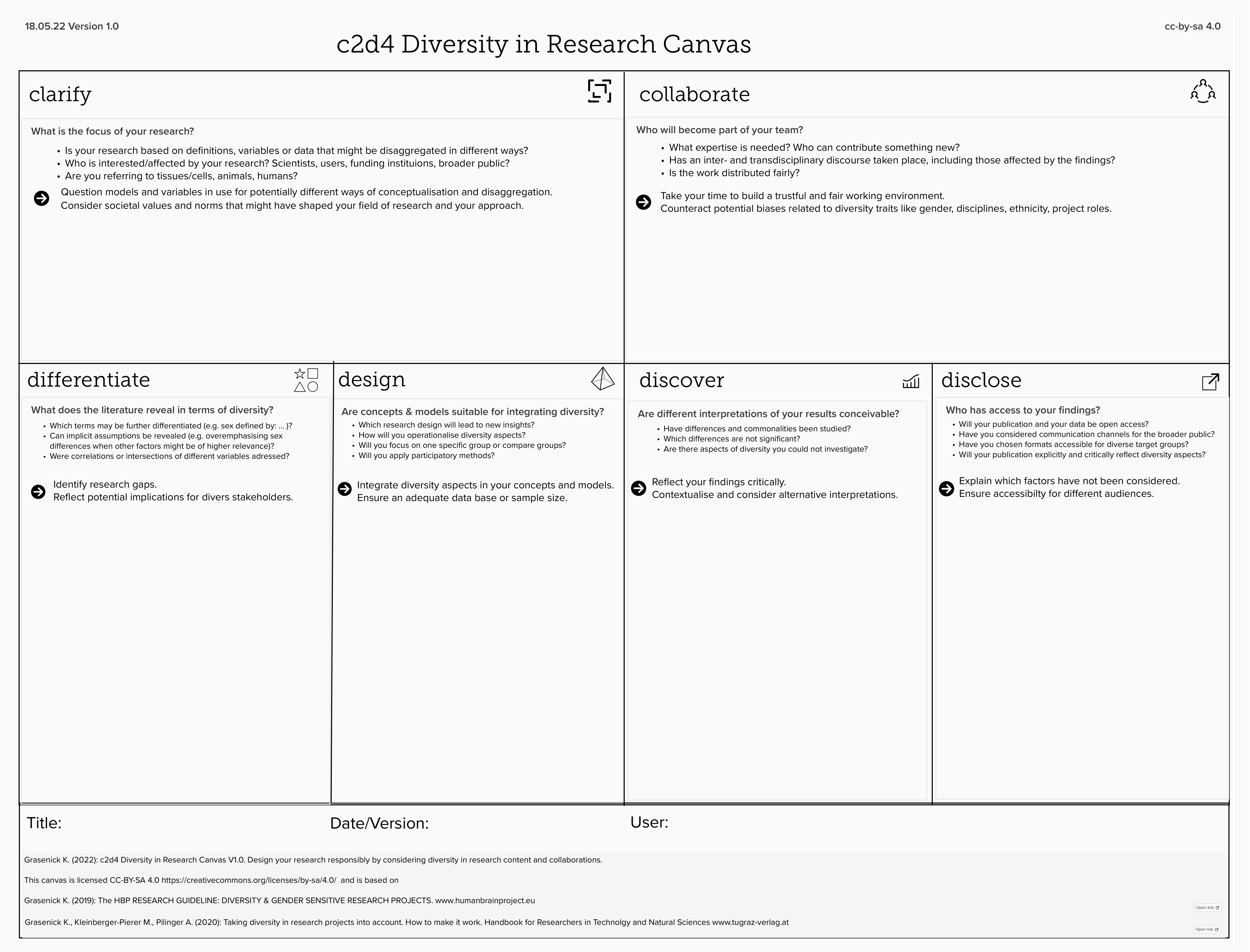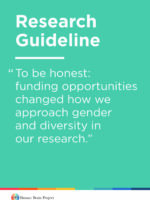Considering sex/gender and other diversity aspects like e.g. age, ethnicity, culture, etc. has been recognized as relevant for new scientific insights. Therefore, it has become a requirement by default for the Horizon Europe programme. Examples are outlined in the second “Gendered Innovations” policy report.
Scientists have been criticised that their research questions and/or conclusions have been driven by biases and a lack of reflection, e. g. by extrapolating results achieved with one group of research subjects compared to other groups in disregard of potential differences between these groups. This neglect has led to the request to consider diversity in research more carefully, e. g. for research relevant for medical treatments or societal applications.
This toolkit guides you through the research process with six chapters:
-
- What is your Focus?
- What does the literature reveal in terms of diversity?
- Are concepts and models suitable for integrating diversity?
- Are different interpretations of your results conceivable?
- What research design will lead to new insights?
- Does the diversity of the research team match the requirements?
The chapters are summarized in the HBP Research Guideline which offers you additionally some basic definitions as well as an overview on the literature.
Our 30 Minute Video “of Mice, Men and Machines” is an introduction with practical examples from brain research and AI.
In the webinar “Diversity in brain research: Does it matter?” moderated by Prof. Katrin Amunts, invited speakers Prof. Lutz Jäncke and Dr. Frances-Catherine Quevenco, who is part of the Women’s Brain Project, discussed recent findings and different viewpoints on how and when sex/gender differences in brain research are relevant. The Human Brain Project also presented the winners of our Diversity In Research Paper Awards (DIRPA), who outlined their own research results and joined the discussion:
- Sanne Peters et al. (2020): “Sex differences in the association between major risk factors and the risk of stroke in the UK Biobank cohort study” and
- Yi Zhang et al. (2021): “The Human Brain Is Best Described as Being on a Female/Male Continuum: Evidence from a Neuroimaging Connectivity Study”.
In neuroscience, scientists have studied differences, especially sex differences (Jäncke, 2018). Most evidently sex chromosomes differ and can be traced down to the level of stem cells (Shah, 2014). They effect the production of hormones which again are measurable in the brain and influencing functional responses. (Cahill, 2014). “For example, studies have demonstrated that cells and the central nervous systems of male and female mice react differently to chemical stressors with potentially severe consequences for drug design and treatments for brain diseases like Parkinson stroke. Neurodegenerative diseases such as multiple scleroses take different courses for women and men. For neuroscientists, sex can be a key variable that should be addressed not only when studying humans but also when working with animals and cell cultures” (Grasenick, 2019).
Simultaneously, neuroscientists have been criticised for binary approaches, the false assumption that female and male brains are dimorphic. Based on such binary assumptions it has been argued that cognitive and emotional abilities, societal roles are biologically grounded (Rippon et.al, 2019). Eliot et. al. (2021) therefore recommend to “Dump the ‘dimorphism’” and according to Joel et. al. (2015) “human brains are comprised of unique ‘mosaics’ of features, some more common in females compared with males, some more common in males compared with females, and some common in both females and males.”
Examples related to Artificial Intelligence (AI) show that it is not only essential to consider sex and gender, but also further diversity traits such as race or ethnicity: Facial recognition can be discriminating based on characteristics such as race and gender and their intersections (Buolamwini & Gebru, 2018). Such inequalities stemming from AI technologies might even lead to exacerbating health care disparities when unintentionally perpetuating sex, gender and race biases (Zou & Schiebinger, 2021).
For this reason, intersectional approaches considering other diversity aspects such as age, ethnicity, socioeconomic background, etc. has been recognized as relevant for new scientific insights (EC, 2020b). Read more on sex, gender and diversity here.
References
Buolamwini, J., & Gebru, T. (2018). Gender shades: Intersectional accuracy disparities in commercial gender classification. Proceedings of Machine Learning Research, 81, 77-91. http://gendershades.org
Cahill, Lary(2014): Fundamental sex difference in human brain architecture. In: Proceedings of the National Academy of Sciences of the United States of America. Vol. 111, p. 577-578. DOI: 10.1073/pnas.1320954111
Eliot, Lise et. al. (2021): Dump the “dimorphism”: Comprehensive synthesis of human brain studies reveals few male-female differences beyond size. In: Neuroscience and Biobehavioral Reviews, June 2021; Vol. 125, p. 667-697. DOI: 10.1016/j.neubiorev.2021.02.026
European Commission (2020): Non-discrimination. URL: https://ec.europa.eu/info/aid-development-cooperation-fundamental-rights/your-rights-eu/know-your-rights/equality/non-discrimination_en
Grasenick, Karin (2019): Same, same – or different? Common Challenges in Neuroscience, AI, Medical Informatics, Robotics and New Insights with Diversity & Ethics. In: The Neuroethics Blog. URL: http://www.theneuroethicsblog.com/2019/09/same-same-or-different-common_10.html
Jäncke, Lutz (2018): Sex/gender differences in cognition, neurophysiology, and neuroanatomy. In: F1000Research 2018 (F1000 Faculty Rev): 805. DOI: http://dx.doi.org/10.12688/f1000research.13917.1
Joel, Daphna et.al (2015): Sex beyond the genitalia: The human brain mosaic. In: Proceedings of the National Academy of Sciences of the United States of America. Vol. 112, No. 50, p. 15468-15473. DOI: https://doi.org/10.1073/pnas.1509654112
Rippon Gina, Eliot Lise, Genon Sara, Joel Daphna (2021): How hype and hyperbole distort the neuroscience of sex differences. In: PLoS Biology, Vol. 19, No. 5. DOI: https://doi.org/10.1371/journal.pbio.3001253
Schiebinger, Londa (2014). Gendered innovations: harnessing the creative power of sex and gender analysis to discover new ideas and develop new technologies; Triple Helix 2014, 1:9 http://link.springer.com/article/10.1186/s40604-014-0009-7
Shah, Kalpit, McCormack, Charles E., & Bradbury, Neil A. (2014): Do you know the sex of your cells? In: American Journal of Physiology-Cell Physiology, Vol. 306, No.1, p. C3–C18. DOI: https://doi.org/10.1152/ajpcell.00281.2013
Woolley, Catherine S. (2021): His and Hers: Sex Differences in the Brain. In: Cerebrum, Winter edition, 15.01.2021. URL: https://dana.org/article/cerebrum-sex-differences-in-the-brain/ [17.08.2021]
Zou, J. & Schiebinger, L. (2021). Ensuring that biomedical AI benefits diverse populations. EBioMedicine, 67, 1-6. DOI: https://doi.org/10.1016/j.ebiom.2021.103358
Research Canvas
The c2d4 Diversity in Research Canvas below shows how diversity aspects can be considered in all steps of the research process.
Videos on Diversity in Research
Learn more about the role of diversity in research in these videos
Research Guidelines
The Research Guidelines offer you support for considering diversity in your research content and methodological approaches.
- Grasenick K. (2019): Research Guideline. Diversity and Gender Sensitive Research Projects. A guideline for sex, gender and diversity in research projects providing guiding questions, examples, and references to literature for research activities with a focus on neuroscience and related fields. DOI: https://doi.org/10.5281/zenodo.5575846
- Grasenick K., Kleinberger-Pierer M., Pilinger A. (2020): Taking Diversity in Research Project into account. How to make it work. A Handbook for researchers in Technology and Natural Sciences. DOI: https://doi.org/10.3217/978-3-85125-753-3-en



